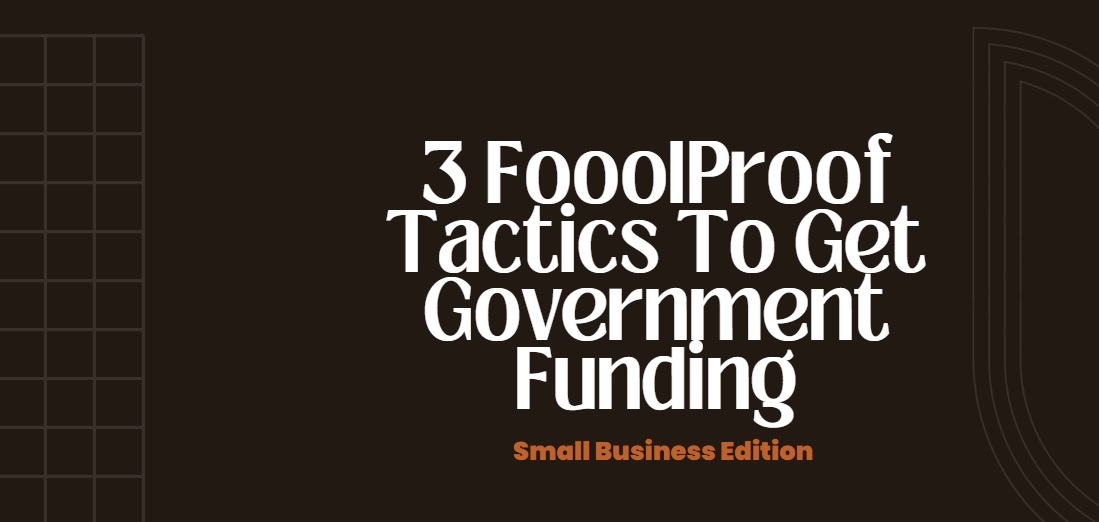3 Foolproof Tactics To Get You More Government Funding Options
Category: Funding & Financing
Tags: Canadian Government Funding, funding options, Government Funding
As a small business owner in Canada, money is crucial to your success. It can help you startup with limited concerns, can help you cover the needed expenses, and assist you with growing your business.
To get more money, the government of Canada has made over 1,500 government funding options available for the taking. Yet nearly 80% of applicants who apply for government funding are often denied, due to simple application mistakes.
Most of the denied funding applications can be summarized into a few points:
- Application is denied because you asked for too much (beyond the limit of what the agency can provide)
- The funding needs listed did not match the funding program
- Insufficient information was provided at time of application
To combat this and to ensure that you as a small business in Canada can take advantage of these funding options and maximize your potential, follow these 3 foolproof tactics:
1. Provide all documents needed
2. Have a clear breakdown of your funding needs
3. Ensure you read the program criteria
Sounds simple, right?
Yet the 80% of applicant’s who have applied and been denied fall into the simple trap of not following the basics of the applications. Getting money can be exciting, so it’s easy to make a mistake – perhaps it’s inexperience with the complex applications – but no matter what, the 3 foolproof tactics here will help ensure you get more out of government funding.
Before we get into any explanation, the first step to ensure that you are able to optimize your funding options is to actually know about the funding options in question.
In Canada, there are over 1,500 funding sources. These sources vary from government grants, government loans, tax breaks, credits..etc
To know what you may be eligible for and able to apply to, it is important to read all of the program criteria.
This is the #1, a foolproof step that will ensure you have more options that you can take advantage of – and will mean you are not just applying to something that is not applicable.
Read all of the program criteria carefully
While it sounds simple enough, this first step is what wastes a lot of time and often is the #1 reason for applications being denied – especially when a business owner just completed the application, without reading the steps, rules, criteria.
So, what do you look for in an application?
Well, a few things – but first, start from the top, read all the way to the end. Every word, every detail counts and may impact your chances of success.
The key points you need to make sure of however include:
- Is this program available to business owners in the location that you are in (may be a suburb, a city, a province)
- Does the program cover a specific industry and if so, does your business fit into this industry (keep in mind that businesses can also fit into more than one)
- Can the funding that the program offers be used towards your specific requirements?
- The amount of money that you need, is the agency able to cover it?
If you answered yes to these questions, it is likely that you are a match and can proceed with the application.
Be sure to pay close attention to the rest, consider all requirements and meet the demands that the application or program asks for.
Breakdown your funding needs
To maximize your potential, the next foolproof tactic is to ensure that your funding requirements are clearly outlined and broken down into the very specific of what you need the money for.
Now, how detailed you want to go is entirely up to you, but generally you want to break your needs down to the specific such as:
- Tools and equipment purchase
- Wages or hiring costs
- Training costs
- R&D
- Marketing costs
- Renovation costs
- …etc
Many small business owners make a mistake by grouping all of the funds together and calling it “startup costs”, or “funding needs” and listing out a lump sum.
In most cases, each funding agency will want to fund specific things (expense); so the more of a breakdown that you have, the better. And at all costs, avoid a lump sum ask; as it will often be denied.
For example:
If your business requires $75,000 in startup support, your chances of getting the full ask amount is much greater by breaking it down and asking for the specific, such as:
- $20,000 for tools and equipment
- $10,000 for marketing costs
- $30,000 for wage and training costs
- $10,000 for website development
- $5,000 for legal fees
By providing this breakdown, you may be able to apply to multiple programs, each that funds a different need that you have listed. Where as if you just asked for $75,000 from one option, you may get denied.
Asking for less; is often better, and by having the breakdown and being able to access money from multiple programs, you stand to get more!
Provide all needed information
Lastly, one of the most crucial steps, and a foolproof tactic to ensure you follow to help maximize your government funding potential is to ensure you provide all needed information that the application asks for.
This may vary from program to program, but often will be related to your business plan, financial statements, a PitchDeck presentation; perhaps some personal documentation and verification documents; bank statements, invoices..etc
Avoid skipping the steps (just because you don’t have something); instead, get it done and ensure you apply with this information that is being asked. Not doing so, will get you denied!
SEARCHES RELATED TO CANADIAN GOVERNMENT FUNDING
Canadian Government Funding
funding options
Government Funding
I WANT START A BUSINESS IN...
IS THERE HELP IN MY INDUSTRY?
- Expansion Capital
- Funding For Equipment
- Business Acquisition Funding
- Consulting Services
- Hiring & Training Staff
- Management Support Services
- Manufacturing
- Mining
- Professional and IT Services
- Transportation and Warehousing
- Accommodation and Food Services
- Agriculture
- Construction
- Culture and Recreation
- Finance and Real Estate
- Forestry, Hunting and Fishing
- Health and Social Assistance





